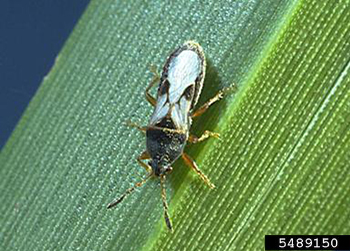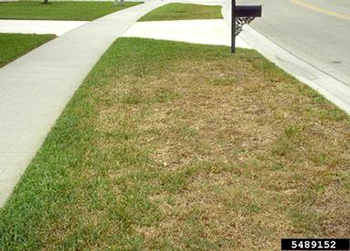
EPPO Alert List – Blissus insularis (Hemiptera: Blissidae)
Southern chinch bug
Why
The southern chinch bug Blissus insularis (Hemiptera: Blissidae) is a damaging pest of turf and pasture grass in Southern USA. As it was recently introduced in Portugal where it is spreading and causing damage, the EPPO Secretariat considered that it should be added to the EPPO Alert List.
Where
B. insularis is reported from Southern USA as well as the Caribbean, and parts of South and Central America.
EPPO Region: Portugal (mainland).
North America: Mexico, USA (Alabama, Arizona, Arkansas, California, Florida, Georgia, Hawaii, Louisiana, Mississippi, New Mexico, Oklahoma, South Carolina, Texas).
Central America and Caribbean: Antigua and Barbuda, Bahamas, Bermuda, Cuba, Dominica, Grenada, Haiti, Jamaica, Martinique, Panama, Puerto Rico, St Vincent and the Grenadines, Trinidad and Tobago, Turks and Caicos Islands.
South America: Colombia.
Oceania: Guam.
On which plants
B. insularis is only reported from St. Augustine grass, Stenotaphrum secundatum (Poaceae). In experiments, it could also develop on other grasses such as Cynodon spp. or Zoysia spp. S. secundatum is a perennial grass that is used for turf and pasture. It is considered invasive in some countries.
Damage
Chinch bugs are sap-sucking species that feed on phloem tissues above and below the soil surface, causing gradual yellowing and eventual death of damaged plants. At first, damage is limited to small patches of dead grass, but eventually entire lawns can be destroyed.
Adults are small, elongated insects, measuring 2.0 to 4.0 mm long and 1.0 mm wide, black with white patches on wings which are folded over the back. A female can lay over 250 eggs in her lifetime. Young nymphs are reddish-orange with a white band across the back. Body colour darkens and becomes black as nymphs reach adult size. The life cycle varies between 10 to 70 days and 3 to 10 overlapping generations are reported annually. B. insularis remains active all year long, even if it may become dormant in winter in the Northern part of its range.
Control is based on a combination of cultural practices (mowing, fertilization, irrigation, use of tolerant varieties) and chemical control with insecticides. B. insularis has shown some resistance to insecticides.
Dissemination
Adults can fly or walk short distances. As the pest was introduced in Portugal, it can be seen that long distance spread can occur but the pathway for introduction is not clear.
Pathways
Plants for planting? Soil?
Possible risks
In the Southern USA, B. insularis is a very damaging pest. Considering its current distribution, B. insularis may only establish in the warmer part of the EPPO region.
Sources
Dellapé PM, Thomas JH (2023) Lygaeoidea species file. Version 5.0/5.0. http://Lygaeoidea.SpeciesFile.org. Accessed 17 February 2023.
Lima A, Valada T, Caetano MF, Franco JC, Ramos AP (2021) First record of the lawn chinch bug Blissus insularis Barber (Hemiptera: Blissidae) in Europe. Phytoparasitica 49, 539–545.
Direcao regionb de Algricultura en pescas de Losboa et Vale do Tejo (2022) Circular n°5/2022 Uma nova praga dos relvados: Blissus insularis Barber, 1918 (Hemiptera: Lygaeidae), percevejo-do-sul-americano. Alertas fitossanitarios. http://www.draplvt.mamaot.pt/alimentacao/avisos-agricolas/Pages/Avisos-Agricolas.aspx
Reinert JA, Chandra A, Engelke MC (2011) Susceptibility of genera and cultivars of turfgrass to southern chinch bug Blissus insularis (Hemiptera: Blissidae). Florida Entomologist 94(2), 158-163. https://doi.org/10.1653/024.094.0206
Woods S (2021) Southern Chinch Bug, Blissus insularis Barber (Insecta: Hemiptera: Blissidae). University of Florida. EENY-226. https://entnemdept.ufl.edu/creatures/orn/turf/southern_chinch_bug.htm
EPPO RS 2021/055, 2023/042, 2023/043


